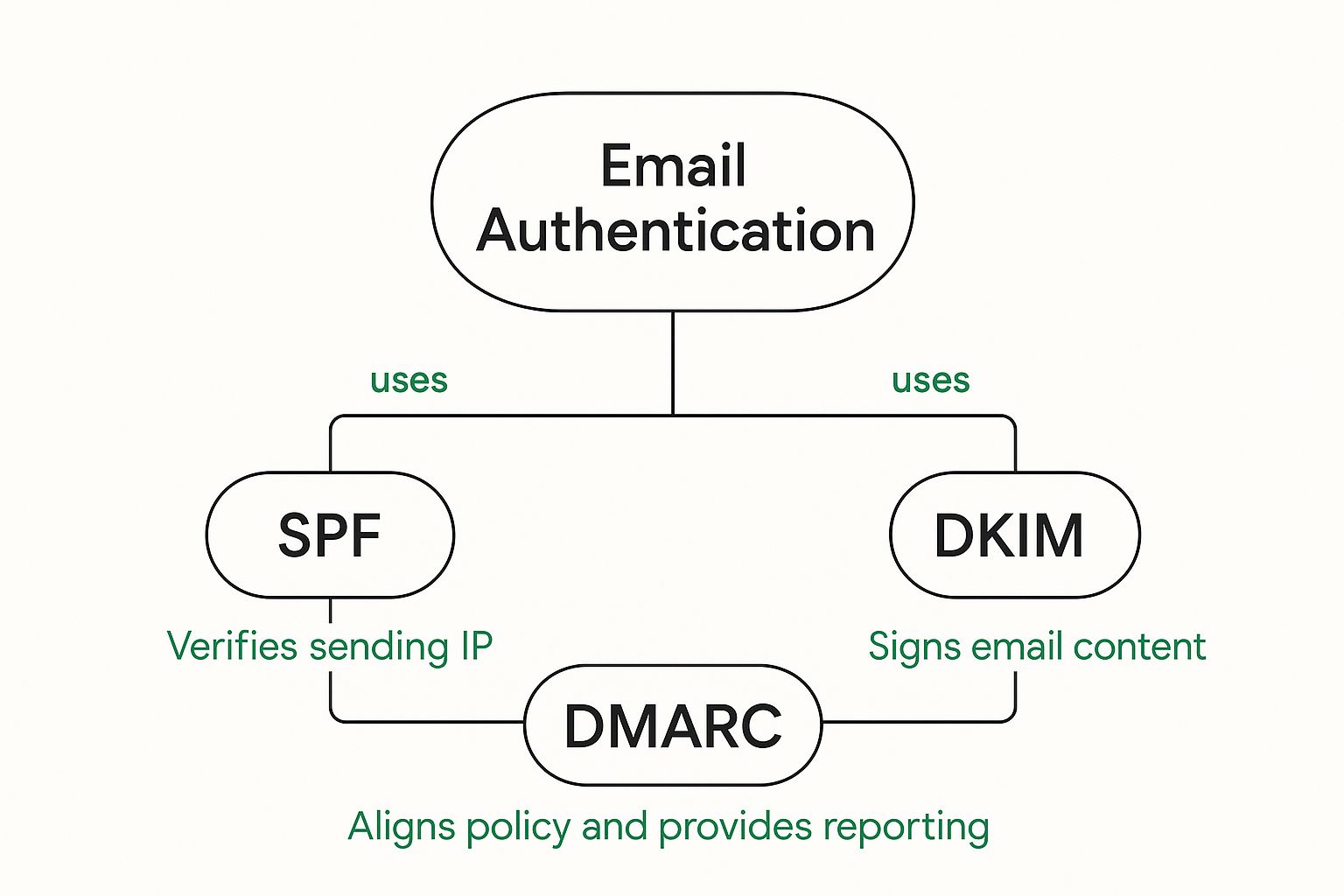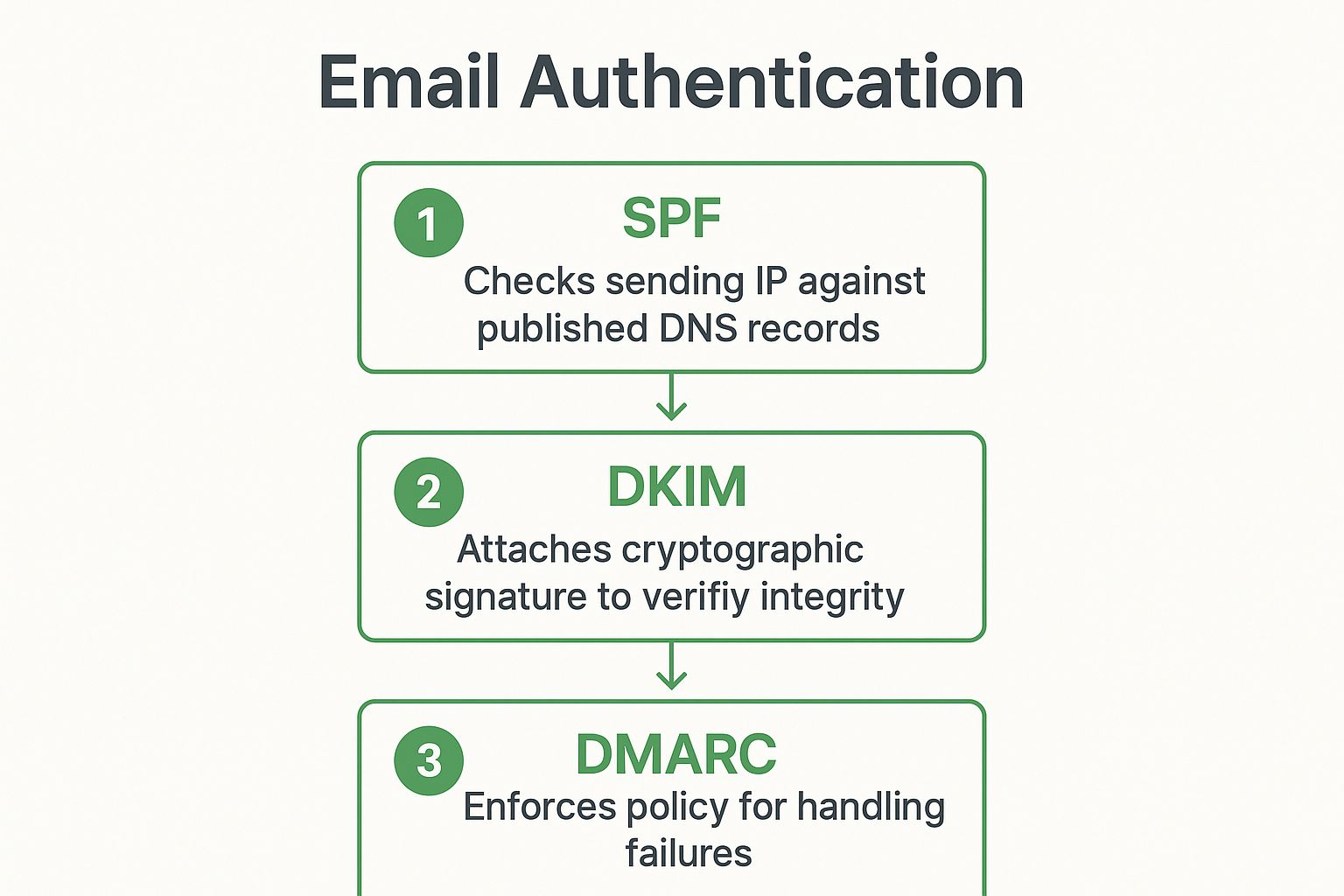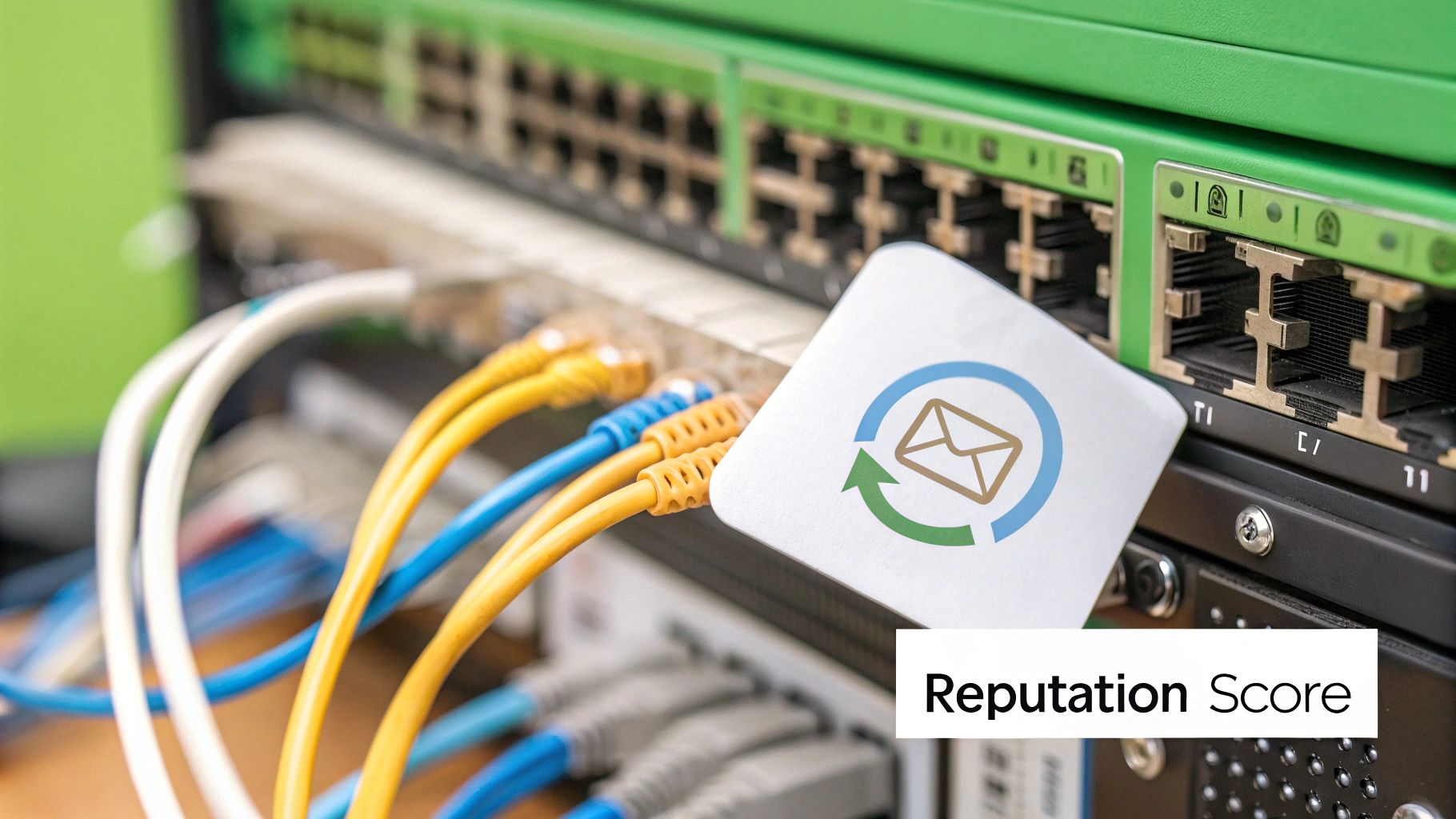It’s one of the most frustrating things in email marketing: you pour time and effort into crafting the perfect message, hit send, and… it disappears into the spam folder. If you're wondering why your emails keep ending up there, the answer is rarely a single mistake. It's usually a combination of signals that make you look untrustworthy to email filters.
Think of email providers like Gmail and Outlook as highly-trained security guards for a very exclusive club—the inbox. Their one and only job is to protect their members from anything annoying or dangerous. And they have to be incredibly strict because the amount of junk trying to get in is staggering.
To give you an idea of what they're up against, a stunning 45.56% of all emails sent across the globe are pure spam. That means nearly half of all email traffic is unwanted garbage. This forces providers to be aggressive with their filtering. You can find more insights about these email trends and see why the filters have to be so tough.
Sending an email isn't like dropping a letter in a mailbox, where delivery is almost a sure thing. It's much more like applying for a loan. You have to prove you’re credible and have a solid history before you’re approved. If you can't build that trust with the inbox providers, your messages get denied at the door.

What Spam Filters Are Actually Looking For
So, how do the "inbox bouncers" decide who gets in? They analyze a few key areas to score your email and decide if it gets delivered, flagged, or blocked completely.
Here's a quick look at the biggest reasons your emails might be getting flagged.
Top 5 Reasons Your Emails End Up in Spam
| Reason | Brief Explanation |
|---|---|
| Poor Sender Reputation | Your sending domain or IP has a history of spam complaints or low engagement. This is the #1 culprit. |
| No Authentication | You haven't set up SPF, DKIM, and DMARC, which are like your email's official ID to prove you're legitimate. |
| Spammy Content | Your subject line, email body, or formatting triggers classic spam filter red flags (e.g., all caps, "free money"). |
| Low Engagement | Your recipients aren't opening or clicking your emails, signaling to providers that your content isn't wanted. |
| Sending to a Bad List | Your email list is full of invalid, old, or unengaged addresses, which leads to high bounce and complaint rates. |
These factors work together to create an overall impression of your sending practices. Getting any one of them wrong can seriously hurt your chances of reaching the inbox.
Here’s a deeper look at the core areas that influence your inbox placement:
-
Your Sender Reputation: This is your digital track record. It’s tied to your sending IP address and your domain, and it keeps a running tally of things like spam complaints and how many people are actually interacting with your emails. A bad reputation is the fastest way to get exiled to the spam folder.
-
Your Technical Setup: Think of proper email authentication (SPF, DKIM, and DMARC) as your official government-issued ID. It proves you are who you say you are. Without it, you look like an imposter trying to sneak past security.
-
Your Content and Engagement: The words you choose, the links you include, and even your image-to-text ratio all matter. But what matters even more is how people react. When recipients open, click, and reply, it sends a powerful positive signal. When they ignore or mark you as spam, it tanks your reputation.
The name of the game in email deliverability is trust. Spam filters are constantly asking one question: "Can I trust this sender to deliver valuable, solicited content to my user?" Your entire email strategy should be built around making the answer a resounding "yes."
Understanding these unwritten rules is the first step toward fixing the problem. You're not just sending an email—you're building a relationship, both with the person you're emailing and with their inbox provider. Every single campaign you send either strengthens that relationship or chips away at it, directly impacting your future success.
Understanding Your Sender Reputation: The Digital Trust Score

Every single time you send an email, you're either building or chipping away at your reputation. The easiest way to think about your sender reputation is as a digital credit score for your email address and sending domain.
In this scenario, Internet Service Providers (ISPs) like Gmail, Outlook, and Yahoo are the lenders. Getting into the primary inbox is the "loan" you're asking for. A high score tells them you’re a trustworthy sender who people actually want to hear from, so they happily wave you through to the inbox. A low score, however, makes them suspicious. Your messages get sent straight to the spam folder, no questions asked.
This score isn't just one static number; it’s a complex picture of your sending habits painted over time. Getting to the bottom of why your emails land in spam starts here. It’s rarely one single mistake but rather a pattern of behavior that ISPs have been watching.
The Two Pillars of Sender Reputation
Your sender reputation really comes down to two main components: your IP reputation and your domain reputation. They're closely linked, but email providers judge them separately, and both are absolutely critical for deliverability.
-
IP Reputation: This is the reputation tied to the mail server that actually sends your emails out into the world. If you're using an email marketing platform or a shared web host, you're likely sharing an IP address with many other senders. This means their bad habits can splash onto you, which is why legitimate email service providers are so incredibly strict with their sending policies.
-
Domain Reputation: This one is all about your website address (like yourcompany.com). It’s a much more permanent score that follows you around, even if you switch email platforms or get a new IP address. Everything from your domain's age to the content you send contributes to this score, making it a powerful, long-term signal of your legitimacy.
You can’t have one without the other. A perfect IP reputation won't save you if your domain reputation is in the gutter, and vice-versa. You need both to be in good standing for consistent inbox placement.
How Your Actions Build—or Break—Your Score
Just like a real credit score, your sender reputation is constantly changing. It goes up and down based on what you do and, more importantly, how your subscribers react to your emails.
Your sender reputation isn't just a technical metric; it's the foundation of all your email efforts. Every email you send is either a deposit into your trust account with ISPs or a withdrawal. A few big mistakes can wipe out months of good behavior.
Here’s a look at the specific signals that ISPs are constantly monitoring:
Negative Signals (These Wreck Your Score):
- High Spam Complaints: When someone hits the "Mark as Spam" button, it’s a massive red flag for ISPs. This is one of the most damaging things that can happen, as it directly tells them your content is unwanted. A complaint rate as low as 0.1%—that's just 1 complaint for every 1,000 emails—can set off alarm bells.
- High Bounce Rates: When an email "bounces" because the address is invalid (a hard bounce), it signals that your list is out-of-date or you're not managing it properly.
- Hitting Spam Traps: These are bait email addresses set up by ISPs specifically to catch spammers. They look real but are never used by people, so sending an email to one is definitive proof that you aren't keeping your list clean.
- Low Engagement: If people consistently ignore your emails, never opening or clicking them, it tells ISPs that your content just isn't resonating with your audience.
Positive Signals (These Boost Your Score):
- High Open Rates: People opening your emails is a clear sign of interest and approval.
- Clicks and Replies: When subscribers click on links or reply to your messages, it’s an even stronger signal that you’re providing real value.
- Moving from Spam to Inbox: This is a powerful vote of confidence. If a user digs your email out of the spam folder and moves it to their inbox, it tells the ISP their filter made a mistake and helps repair your reputation.
Protecting this digital trust score isn’t a one-and-done task. It demands consistent attention, a commitment to list hygiene, and a laser focus on sending content that your audience is genuinely excited to receive.
The Three Technical Keys to Inbox Delivery
If a strong sender reputation gets you past the first checkpoint, think of email authentication as the official ID you need to present to the final gatekeeper. It's really that simple.
Sending an email without proper authentication is like mailing a package with no return address. Even if the contents are perfectly fine, the post office is going to see it as suspicious and probably refuse to deliver it. It just looks shady.
In the email world, this "official ID" is a trio of technical records: SPF, DKIM, and DMARC. These aren't just best practices anymore. Inbox providers like Gmail and Outlook now see them as mandatory for proving you are who you say you are. A shocking number of deliverability problems boil down to getting these wrong.
SPF: Your Approved List of Senders
The first key is the Sender Policy Framework (SPF). Let's stick with our package analogy. SPF is like a public list you give to every post office that says, "Only mail carriers from these specific companies are allowed to deliver packages with my name on them." Anyone else claiming to be you is an imposter, and they should be treated as such.
Technically, an SPF record is just a line of text you add to your domain's settings. This text lists all the IP addresses that are actually authorized to send email for you. When an email from your domain arrives, the recipient's server glances at your SPF record. If the IP address that sent the email isn't on your approved list, a red flag goes up immediately, and that message is far more likely to get tossed into the spam folder.
DKIM: The Tamper-Proof Digital Seal
Next up is DomainKeys Identified Mail (DKIM). Imagine sealing every package you send with a unique, unbreakable wax seal that only you can create. If that package shows up with a broken seal—or no seal at all—the recipient knows it was either tampered with in transit or is a complete forgery.
DKIM does almost the exact same thing by adding a unique digital signature to every single email you send. This signature is created with a private key that only your server has access to. The receiving servers then use a public key, which you publish in your domain's settings, to check if the signature is legit.
A valid signature proves two critical things:
- The email genuinely came from your domain.
- The content of the email hasn't been messed with since it left your server.
This is your guarantee against in-transit meddling.

As you can see, it’s a system of checks and balances. SPF validates the server, DKIM protects the message itself, and our final key, DMARC, tells the world what to do when things don't add up.
DMARC: Your Instructions for Suspicious Mail
Finally, we have Domain-based Message Authentication, Reporting, and Conformance (DMARC). This protocol builds right on top of SPF and DKIM. If SPF is the list of approved carriers and DKIM is the tamper-proof seal, then DMARC is the set of instructions you leave with the post office, telling them exactly what to do with packages that fail your checks.
A DMARC policy gives receiving servers clear orders on how to handle emails that claim to be from you but fail either the SPF or DKIM test. You can tell them to:
- None: Do nothing for now. Just let the mail through, but send me a report so I can see what’s happening.
- Quarantine: Go ahead and send the suspicious mail to the spam folder.
- Reject: Block the email completely. Don't let it get anywhere near the recipient.
DMARC is incredibly powerful because it does more than just protect your brand from phishing attacks—it also gives you invaluable feedback. The reports it generates show you who is trying to send email on your domain's behalf, helping you catch unauthorized senders and diagnose delivery issues you'd otherwise never know about.
These three records—SPF, DKIM, and DMARC—are the technical foundation of trust in email today. Getting them configured correctly is simply non-negotiable if you want to consistently hit the inbox. For anyone looking to go deeper, we've put together a guide to improving email deliverability that really gets into the weeds on these topics.
How Your Content Triggers Spam Alarms

Even with perfect technical authentication and a stellar sender reputation, the actual content of your email—the words, images, and links—can be the one thing that lands you in the junk folder. Spam filters have come a long way from simply flagging obvious trigger words. They now operate like savvy AI detectives, analyzing the entire message for any hint of deceptive or low-quality patterns.
Think of it like this: your email has passed the background check (authentication) and has glowing references (sender reputation), but now it's in a final interview with the spam filter. What you say and how you say it matters immensely. One wrong move, and your message gets shown the door. It’s surprising how often this is the culprit behind deliverability problems.
The Problem with "Spammy" Language
Years ago, you could avoid the spam folder just by dodging words like "free money," "act now," or "viagra." While those are still definite red flags, the game has changed completely. Today, modern AI spam detection systems look at the bigger picture and the context, not just isolated words.
They’re scanning for things like:
- Deceptive Subject Lines: A classic spammer move is to use a subject line that misleads the reader, like adding "Re:" or "Fwd:" to fake an ongoing conversation.
- Excessive Punctuation and Caps: TYPING IN ALL CAPS or using a ton of exclamation points (!!!) just looks desperate and unprofessional, mimicking the exact style spammers use.
- High-Pressure Sales Tactics: Phrases like "Limited Time Offer" or "Buy Now Before It's Gone" can set off alarms, especially if they feel too aggressive.
Content Red Flags That Trigger Spam Filters
The way your email is built sends powerful signals to inbox providers. To help you stay on the right track, here’s a quick comparison of common content mistakes versus the best practices that will keep you in the clear.
| Content Element | Spam Trigger (Avoid) | Best Practice (Adopt) |
|---|---|---|
| Subject Line | "Re: Your Urgent Action Required!!!" | "A quick question about your account" |
| Imagery | One large image with no text | A balanced mix of text and relevant images |
| Links | Shortened URLs (e.g., bit.ly) | Full, descriptive, and reputable links |
| Language | "Click here now! 100% Free Guaranteed!" | "Learn more about our free trial." |
| Formatting | BRIGHT RED FONTS AND ALL CAPS | Clean, professional, and easy-to-read text |
This table is just a starting point, but it highlights a key principle: your email should be built for humans first. If it looks or feels deceptive, spam filters will notice.
Your Message Composition Matters
Beyond the words you choose, the very structure of your email is under scrutiny. Filters are naturally suspicious of emails that seem designed to hide something or trick the user.
A common mistake is sending an email that is just one giant image. Spammers have long used this trick to hide spammy text from filters, so an email with little to no actual text is an immediate red flag. Always aim for a healthy text-to-image ratio.
The quality and transparency of your links are also a huge deal. Spam filters are incredibly protective of their users and will examine where you’re trying to send them.
Link-Related Red Flags:
- Using URL Shorteners: Services like bit.ly are a favorite tool for spammers trying to mask shady destination URLs. Stick to your full, transparent domain links.
- Linking to Shady Domains: If you include a link to a website with a poor reputation, that bad reputation gets splattered all over your email.
- Misleading Link Text: The anchor text for your link needs to accurately describe where the user is going. A link that says "See Our New Collection" but goes to a generic sign-up form is a big problem.
Finally, never underestimate the power of good old-fashioned proofreading. While a single typo probably won't sink you, a message full of grammar and spelling errors screams unprofessionalism—a hallmark of spam and phishing attempts. A quick read-through is a simple but vital step. To get a deeper dive into protecting your campaigns, our guide on how to reduce spam email offers even more practical advice.
Why a Healthy Email List Is Your Best Asset
Who you send your emails to is just as important—if not more so—than what’s in them. You could have flawless domain authentication and the most compelling content in the world, but if you’re blasting it out to a stale, disengaged list, you're actively tanking your sender reputation with every campaign.
It's a common blind spot, and often the real answer to "why are my emails going to spam?"
Think of your email list less like a giant megaphone and more like a private club. Wouldn't you rather have a smaller room filled with people who genuinely want to be there than a cavernous stadium full of people ignoring you or heading for the exits? When your list is cluttered with invalid addresses or subscribers who never open your messages, you’re basically shouting into an empty room.
And the big email providers like Gmail and Outlook are watching. They see high bounce rates and low engagement as clear signals that your emails aren't wanted. This hammers your digital trust score and makes it almost certain your future campaigns will get sidelined.
Quality Over Quantity, Always
One of the biggest mistakes I see people make is obsessing over the subscriber count while ignoring the quality of those subscribers. Let me be clear: a list of 1,000 engaged fans who consistently open and click is infinitely more valuable than a list of 50,000 silent subscribers who are poison to your sender score.
Keeping your list clean—a practice we call list hygiene—isn't optional. It's a fundamental part of successful email marketing.
Here’s what a poorly maintained list signals to inbox providers:
- High Bounce Rates: Emails that can't be delivered tell providers your list is old and neglected. It's a huge red flag.
- Low Open Rates: If nobody's opening your emails, it shows your audience has lost interest. Why should a provider deliver something nobody reads?
- Spam Complaints: This is the ultimate killer. Sending to people who don't remember signing up is the fastest way to get your domain flagged.
These negative signals are hard proof that your sending practices aren't up to snuff, and spam filters will react accordingly.
A healthy email list is a living asset that requires regular maintenance. Ignoring list hygiene is like never changing the oil in your car—eventually, the engine will seize, and your deliverability will grind to a halt.
How to Build and Maintain a Strong List
A great list starts at the very beginning: the signup process. The gold standard here is the confirmed opt-in (you might also hear it called a double opt-in). This simple step requires a new subscriber to click a confirmation link sent to their email, proving two things: they gave you a real email address, and they actually want to hear from you.
Beyond that, you have to get comfortable with pruning your list. Regularly clearing out inactive subscribers—people who haven't opened or clicked an email in, say, 90 or 180 days—is crucial. Yes, your list size will drop, and that can feel counterintuitive. But in reality, you're strengthening your deliverability by boosting your overall engagement metrics.
It's also helpful to see things from the other side. You can explore some of the top email spam filters to protect your inbox to understand exactly what your messages are up against.
With an estimated 376.4 billion emails flying across the internet daily in 2025—and nearly half of that being spam—inbox providers are more aggressive than ever. A clean, engaged list is your proof that you’re one of the good guys, a sender whose messages deserve to be seen. The inbox is a competitive place, and these practices are what it takes to win.
Your Action Plan to Avoid the Spam Folder
Alright, let's turn all this knowledge into action. If you're tired of wondering "why does my email go to spam," this is your roadmap out. I've boiled down the complexities into a straightforward checklist to help you systematically diagnose and fix what’s going wrong.
Think of it like a pilot's pre-flight check before takeoff. Running through these key areas before you launch a campaign builds a foundation of trust that inbox providers like Gmail and Outlook will recognize—and reward.
First, Check Your Technical Foundation
Your technical setup is basically your email's passport. If it's not in order, you're not getting past the first checkpoint. This stuff is non-negotiable for proving you are who you say you are.
-
Review Your Authentication: The very first thing to do is confirm your SPF, DKIM, and DMARC records are set up correctly. These three work together to prove your emails are legitimate and haven't been faked. A simple misconfiguration here is one of the most common reasons good emails get blocked.
-
Warm Up Your IP Address: If you’re sending from a new IP address or domain, you can't just start blasting out thousands of emails. You have to "warm it up." Start by sending small batches to your most engaged subscribers, then gradually increase the volume over time. This process builds a positive sending history right from the start.
Next, Audit Your Content and List Hygiene
Once your technicals are solid, the focus shifts to what you're sending and who you're sending it to. This is how you show inbox providers that your messages are actually wanted.
The fastest way to ruin a good sender reputation is to send mediocre content to an unengaged list. Every ignored email is a negative signal that tells inbox providers your messages aren't a priority for their users.
Start with these two steps:
-
Analyze Your Content: Take a hard look at your subject lines. Does anything feel like clickbait? Cut the aggressive sales language ("Act now!", "100% Free!") and make sure your email has a good text-to-image ratio. And definitely avoid URL shorteners—they are a classic red flag for spam filters.
-
Implement a List Cleaning Schedule: Don't be afraid to say goodbye to subscribers who haven't opened your emails in the last 90-180 days. A smaller, highly engaged list is infinitely more valuable for your sender reputation than a huge, inactive one. For a deep dive into more strategies, check out this ultimate guide to email spam avoidance best practices.
Common Questions About Email Deliverability
Even when you think you've checked all the boxes, you'll still run into nagging questions about email deliverability. It's incredibly frustrating when you've done everything right, only to find your message buried in the junk folder. Let's tackle some of the most common questions that pop up when people are trying to solve the "why do my emails go to spam" puzzle.
Think of it this way: getting an email delivered isn't about one single thing. It’s a whole system of moving parts, and sometimes the problem isn't one big mistake, but a few small, subtle things adding up. Understanding these little details is the real secret to consistently hitting the inbox.
How Do I Know If My Domain Is Blacklisted?
Landing on a blacklist is one of the quickest ways to kill your email deliverability. A blacklist is essentially a real-time naughty list of domains and IP addresses known for sending spam. If your domain ends up on one, many email providers will just flat-out reject your messages before they even have a chance.
You can check your status pretty easily with free online tools. Just search for "email blacklist check," and you'll find plenty of services where you can plug in your domain. If you are on a list, the tool will usually tell you which one and provide a link to the blacklist provider. From there, you'll need to follow their specific steps to get removed, which almost always involves proving you've fixed whatever got you listed in the first place.
Getting blacklisted is a serious headache, but it’s usually fixable. Treat it as a huge red flag that something is fundamentally broken—maybe a compromised account is sending spam for you, or your email list hygiene is in really bad shape.
Why Do My Emails Go to Spam in Gmail but Not Outlook?
This happens all the time, and it perfectly illustrates a key point: every email provider plays by its own rules. Gmail, Outlook, Yahoo—they all have their own secret sauce, their own unique algorithms for deciding what's spam and what isn't. An email that sails right into an Outlook inbox might get flagged immediately by Gmail.
So, what causes this? A few things are at play:
- User Behavior Data: Gmail has a staggering amount of data on how its users interact with emails. If your messages look anything like other emails that Gmail users have reported as spam, its filters are going to be extra suspicious.
- Different Filtering Priorities: One provider might be really sensitive about the kinds of links in your email, while another cares more about your sender reputation and whether people are actually opening your messages.
- Separate Reputations: Believe it or not, your domain can have a different reputation with each provider. You might have a great track record with Outlook users but a spotty one with the Gmail crowd, leading to completely different results.
This is exactly why you can't just focus on pleasing one provider. Following universal best practices for authentication, content, and list management sends the right signals to all of them, no matter how quirky their filters are.
Ready to take back control of your inbox? Typewire offers secure, private email hosting with advanced anti-spam protection, ensuring your important messages are seen. Start your free 7-day trial and experience an ad-free, no-tracking email service at https://typewire.com.





